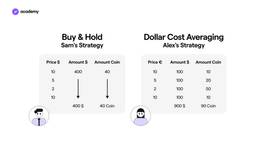Dollar Cost Averaging: How it Works, Pros and Cons
September 27, 2021
6 min

Dollar Cost Averaging, or Value Averaging is a very popular savings and investment strategy among savers with modest and stable incomes, without large amounts of capital at their disposal.
How Dollar Cost Averaging works
If you have already read the Investor’s Handbook, you will know that before applying a strategy you need to fully understand your finances, establish your risk profile and your savings or investment goals. In short, you need to know what you’re doing before you go full speed ahead.
For those who are interested in a long-term purchase plan and do not have the skills of a trader, the DCA has advantages.
The strategy consists of buying a certain amount of an asset at regular intervals.
It sounds simple, it sounds obvious, but in the totally irregular context of the financial market, nothing is a given.
What is the point of regularly buying an asset that follows market cycles and experiences unpredictable volatility?
Precisely because the market is subject to cyclicality and volatility, investors often suffer the psychological effects of managing capital at risk. Many, whether they like it or not, are influenced by cognitive bias or fear.
Buying steadily, come rain or shine, makes you completely independent of these biases, and in the long run, you will achieve a natural cost-offset effect.
If you buy every 15th of the month, and in January and February we are in a bull market, the asset will cost more, but if in March and April we are in a bear market, you will be able to amortise the total cost. This is why it is called Cost or Value Averaging, because you get an average cost or price.
Let’s compare it with the other most popular strategy for cryptocurrencies, the Buy&Hold, which is buying in a bear market (or supposedly so) and holding the cryptocurrencies for a long period, hoping to sell at a high profit after months or years of growth.
Here we have Andrea, who adopts the Buy&Hold strategy. In this example, he bought at a high price compared to the average, as he could not predict market movements. With €400 at the end of the period he still has €400.
Chiara, on the other hand, decided to adopt the Dollar Cost Averaging strategy, spending €100 4 times over the same period. Being able to take advantage of positions at different prices, at the end of the period she has many more coins than Andrea for an equivalent of €900.
This is not always the case, but the odds are in Chiara’s favour.
We can see the same thing on the price chart:
Buying with 8000€ in one go, I will stay with 8000€ in this market scenario.
With the same price movements, buying for 1000€ per month, in August I will have 4.7% more than the starting amount.
Creating a Dollar Cost Averaging plan
The parameters to be decided according to your profile are:
- Which asset(s) to buy
- How long the Dollar Cost Averaging plan will last
- The total amount and single purchases amount
- The frequency of purchases
First of all, you need to know very well the instruments you are going to choose, because if you know the patterns and cycles of its market, you can better orientate yourself on when to start your DCA plan or even at what time of the week or month to set your automatic purchase.
Dedicating a Dollar Cost Averaging plan to a financial instrument means that you believe in its potential, both in terms of reserving value and growth. Remember that the instrument you choose is closely linked to your risk profile.
Depending on your purpose, you may choose to accumulate a safe-haven asset, for example, or create an accumulation plan to make your crypto portfolio flourish.
Dollar Cost Averaging Pros
- It reduces the risk of spending all your capital at market highs. If you buy a large amount in one tranche, and the next day the market starts to fall, you have no liquidity left to allocate. If, on the other hand, you spread the amount over several frequent purchases in the same scenario, you will have spent the money more intelligently. It will be impossible to use all your money at the market maximum.
- You don’t have to have a lot of capital available immediately. Over time you will accumulate it and you can decide how long you want to carry on this way of buying.
- It gives you time to understand the asset and the mechanics of the market by experimenting with small amounts. As time goes by, you gradually accumulate and learn more and more.
- It reduces emotional stress. Even experienced investors can fall into the trap of fear or enthusiasm. That is why it is necessary to be aware of one’s limits and take measures to avoid falling victim to the moment. This strategy is one possible measure.
Dollar Cost Averaging Cons
- More transactions mean more fees. Consider this when deciding on the amount and frequency of each purchase.
- Not in all scenarios will you make convenient purchases and therefore it is not worth using Dollar Cost Averaging in the short to medium term.
Who popularised it
This mode was made known in the 1950s by Benjamin Graham, the father of fundamental analysis and spiritual master of investor Warren Buffett.
Graham suggested buying stocks at regular intervals and with the same amount of money. He said that the more diluted the investment, the better the results. He also advised diversifying the stocks to cushion the risk.
Today, in the Accumulation Plans currently offered by institutions, investments are generally made in funds or ETFs, but we know that in the world of cryptocurrencies there are many other opportunities that are not offered by institutions.




